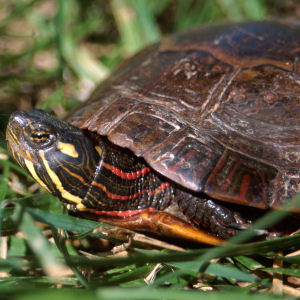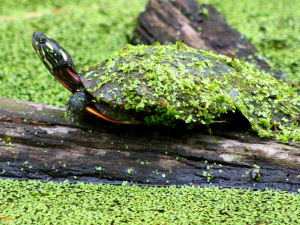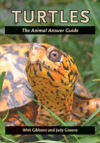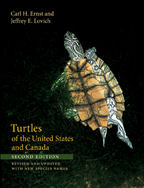
HOME
INTRO
SYMBOLS
ALMANAC
ECONOMY
GEOGRAPHY
STATE MAPS
PEOPLE
FORUM
NEWS
COOL SCHOOLS
STATE QUIZ
STATE LINKS
BOOK STORE
MARKETPLACE
NETSTATE.STORE
NETSTATE.MALL
GUESTBOOK
CONTACT US


Vermont State Reptile

Vermont State Reptile: Painted Turtle
Photographer: John J. Mosesso
National Biological Information Infrastructure
Behind the adoption of the painted turtle as the state reptile of Vermont, we find elementary school students from the Cornwall School (Technically: Anna Sunderland Stowell Bingham Memorial School) in Cornwall, Vermont.
According to the resolution, the painted turtle was adopted because:
- the turtle is a hard worker and can withstand cold temperatures like the citizens of Vermont;
- its colors represent the beauty of our state in autumn;
- it adds to the state's natural diversity;
- it adds to the beauty of our ponds;
- it helps control insect pests;
- it's one of the most common turtles in Vermont.
Cornwall students were also behind the adoption of Vermont's cold water and warm water fish in 1978 and state butterfly in 1987.
State Senator Elizabeth Ready introduced the Senate joint resolution, J.R.S 57, on January 11, 1994. It was referred to the Senate Natural Resources & Energy Committee where it languished for a couple of months.
J.R.S. 57 came out of comittee with a favorable recommendation and was approved by the full Senate on March 23, 1994.
The House of Representatives took a month and a half to also approve the resolution on May 16, 1994.
Needing no signature by Governor Howard Dean, the painted turtle became the state reptile of Vermont on May 16, 1994.
NO. R-179. JOINT RESOLUTION RELATING TO THE DESIGNATION OF THE PAINTED TURTLE AS THE STATE REPTILE.
(J.R.S. 57)
Offered by: Senator Ready of Addison County.
Whereas, the Painted Turtle is a hard worker and can withstand cold temperatures like the citizens of Vermont, and
Whereas, the colors of the Painted Turtle represent the beauty of our state in autumn, and
Whereas, the Painted Turtle adds to the diversity of Vermont's habitat, and
Whereas, ponds are an attractive part of Vermont's landscape and the Painted Turtle adds to that beauty, and
Whereas, Painted Turtles help control the number of insect pests in Vermont, and
Whereas, the Painted Turtle is one of the most common turtles in Vermont, now therefore be it
Resolved by the Senate and House of Representatives:
That the General Assembly hereby recognizes the Painted Turtle as the official state reptile, and be it further
Resolved: That the Secretary of State is directed to forward a copy of this resolution to the students of Cornwall Elementary School inasmuch as their efforts resulted in legislative recognition of this fine reptile.
Vermont Law
The Vermont state reptile was approved by a joint resolution. A Vermont joint resolution is used to "express the sentiments of the legislature" and does not require the signature of the governor. A joint resolution, as passed to adopt the state reptile, requires the approval of both the State House of Representatives and the State Senate. Resolutions are not written into the Vermont Statutes and do not carry the full weight of law.
As of February 23, 2012, the cold and warm water fish and the state reptile are the only Vermont symbols declared by resolution and not written into the Vermont Statutes.
Sources...
The State of Vermont. The Vermont State Legislature. Senate Joint Resolution No. 57. Montpelier: The State of Vermont, 1994. Web.
"Vermont's Legislative Process." Vermont State Legislature. The State of Vermont, n.d. Web. 23 Feb 2012.
Shearer, Benjamin F. and Barbara S. State Names, Seals, Flags and Symbols: A Historical Guide Third Edition, Revised and Expanded. Westport, Conn: Greenwood Press, 3 Sub edition, 2001.
Additional Information

Vermont State Reptile: Painted Turtle
Photograph: Dave Fitzpatrick, U.S. Fish & Wildlife Service
Chrysemys picta Painted Turtle: Middlebury College: Vermont Reptile & Amphibian Atlas - Digital 2010 Edition.
Chrysemys picta (Painted Turtle): The University of Michigan Museum of Zoology: Animal Diversity Web.
Chrysemys picta - (Schneider, 1783), Northern Painted Turtle : A network connecting science with conservation - NatureServe Explorer: An Online Encyclopedia of Life.
Chrysemys picta (Schneider, 1783): Integrated Taxonomic Information System (ITIS) Here you will find authoritative taxonomic information on plants, animals, fungi, and microbes of North America and the world.
State reptiles: Complete list of official state reptiles from NETSTATE.COM.
More symbols & emblems: Complete list of official Vermont state symbols from NETSTATE.COM.

The Life Cycle of
a Painted Turtle
Andrew Hipp
The Life Cycle of a Painted Turtle, by Andrew Hipp. 24 pages. Publisher: Powerkids Pr; 1 edition (August 2002) Reading level: Ages 4+. Painted turtles are ancient, cold-blooded reptiles that lay eggs and must hibernate through the winters. Readers will learn about concepts such as predation, reproduction, hibernation, and life span through studying the lives of these amazing creatures.

Turtles
Turtles: The Animal Answer Guide, by Whit Gibbons and Judy Greene. 184 pages. Publisher: The Johns Hopkins University Press; First Trade edition (November 12, 2009) Ever wonder how many kinds of turtles there are? Or if they have teeth? Why so many turtles have yellow stripes on their neck? If it is wise to feed turtles in your neighborhood pond or lake? Whit Gibbons and Judy Greene, two internationally known turtle biologists, provide complete answers to the most frequently asked questions about the more than 300 turtle, tortoise, and terrapin species of the world.

Turtles of the
United States and Canada
Turtles of the United States and Canada, by Carl H. Ernst and Jeffrey E. Lovich. 840 pages. Publisher: The Johns Hopkins University Press; second edition edition (May 12, 2009) Ernst and Lovich's thoroughly revised edition of this classic reference provides the most updated information ever assembled on the natural histories of North American turtles.
Each species account contains information on identification, genetics, fossil record, distribution, geographic variation, habitat, behavior, reproduction, biology, growth and longevity, food habits, populations, predators, and conservation status. The book includes range maps for freshwater and terrestrial species, a glossary of scientific names, an extensive bibliography for further research, and an index to scientific and common names.

